Prime rib is one of the best special occasion meals, and special occasion for good reason: it’s expensive! But it’s so delicious, and it’s just wrong that we deprive ourself of it most of the time 😉 No more, thanks to the magic of sous vide! Chuck roast makes an excellent prime rib dupe.
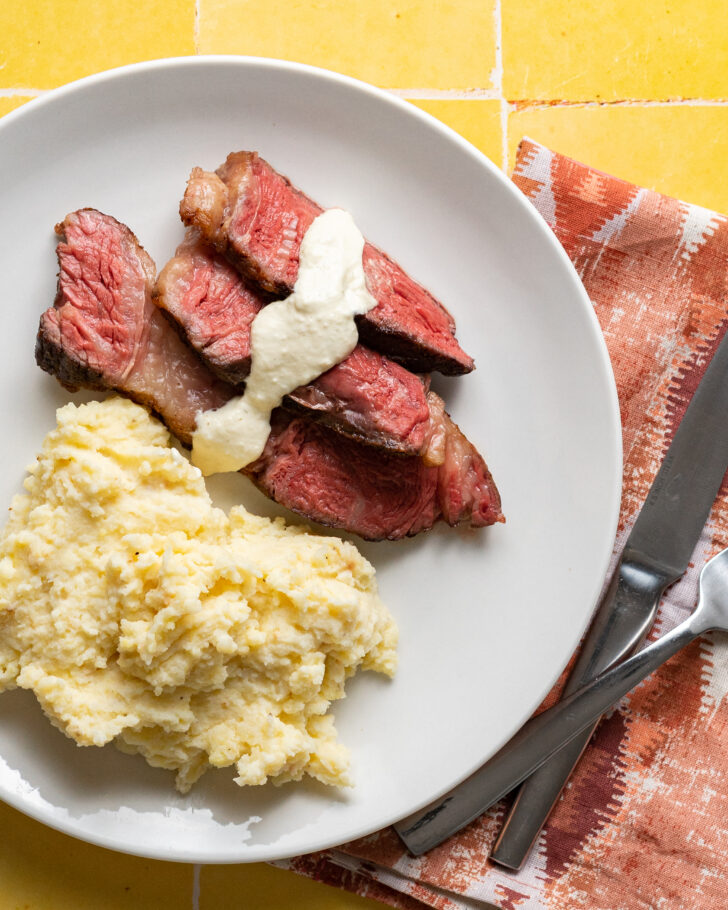
If you get me talking about sous vide, you’ll quickly learn how passionate I feel that sous vide should not be reserved for professional chefs or food nerds. It makes cooking easier and more affordable for home cooks, and they should be taking advantage! In fact, I wrote a whole cookbook about how to use sous vide to make your meal prepping routine easier.
Sous Vide Meal Prep
This cookbook outlines my entire method for keeping your freezer stocked with ready to sous vide meals (and some great recipes to boot!).
Another great thing sous vide can do: make inexpensive cuts of meat amazing. Cuts like sirloin and chuck roast are less prized because they tend to be tougher. With sous vide, we can expose food to heat for a longer period of time without overcooking it, giving us the ability to tenderize it while still keeping it a beautiful medium rare! Pretty cool, huh?
I love to cook other large pieces of meat this way to make things easier. If you’re ready to try other cuts like this after making this recipe, make sure to check these out:
- Sous Vide Whole Chicken
- Sous Vide Pork Loin Roast
- Sous Vide and Smoked Brisket
- Sous Vide Rack of Lamb
- Sous Vide Picanha
What You Need to Make Sous Vide Chuck Roast
If you already sous vide at home, you shouldn’t need anything new to make this recipe! If this is your first time sous viding, don’t worry, we’ll get you set up.
Equipment needed:
- A vacuum sealer and vacuum seal bags
- An immersion circulator
- Some kind of container for your water bath. You can just use a stockpot if you want, but I use a clear, dedicated container.
- Sous vide magnets are handy to keep the bag from floating.
Don’t have a vacuum sealer? No big deal. There are lots of air removal methods.
Time and Temperature for Sous Vide Chuck Roast
Since we’re aiming for a prime rib dupe here, we’re looking for that perfect medium rare. This is a thousand times easier to achieve with sous vide than your classic oven roast! Even better, we’ll get that beautiful medium rare color from edge to edge instead of only at the center.
To get that perfect medium rare, sous vide chuck roast at 135 degrees F for 3-5 hours.
I really recommend sticking to 135 degrees F, but you can go rarer or more well done to suit your preferences.
How to Sous Vide Chuck Roast
This process is incredibly easy. You’re going to wonder why you cook beef roasts any other way after this.
Start by thoroughly seasoning the roast with salt and pepper. Don’t be shy!
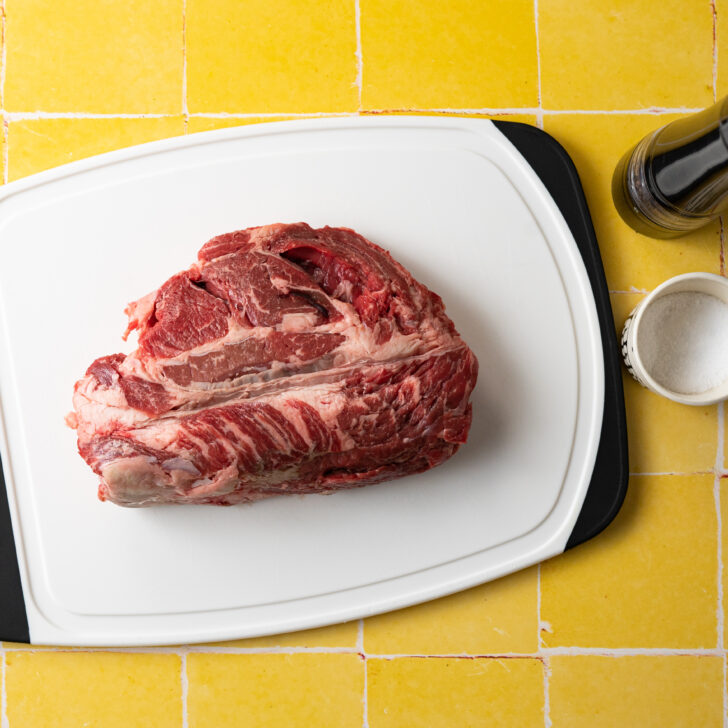
Vacuum seal the roast – if you don’t have a vacuum sealer, there are plenty of other air removal methods.
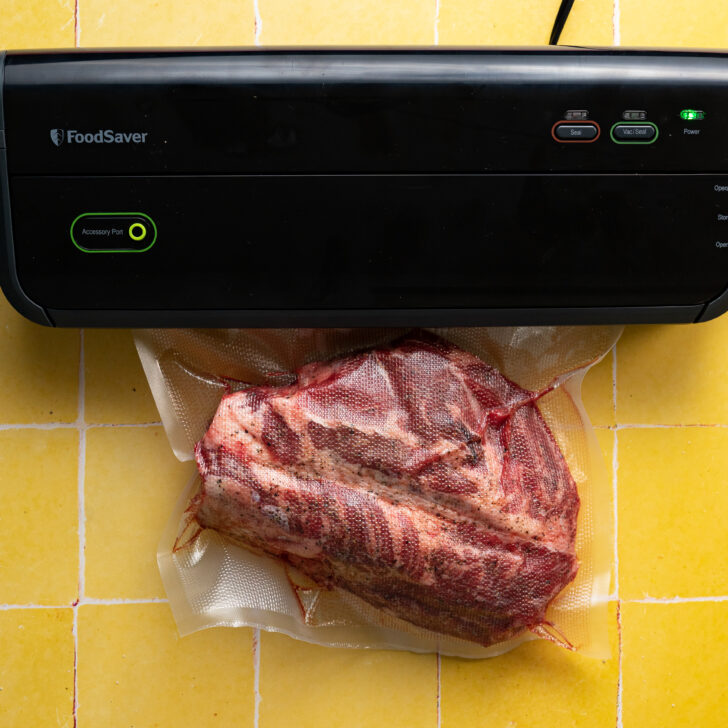
Time to cook! Preheat a water bath using an immersion circulator to 135 degrees F and add the vacuum sealed roasts. Since this is a fatty cut, some air may end up filling the bag during the cooking process and the bag may want to float. I prevent this using sous vide magnets.
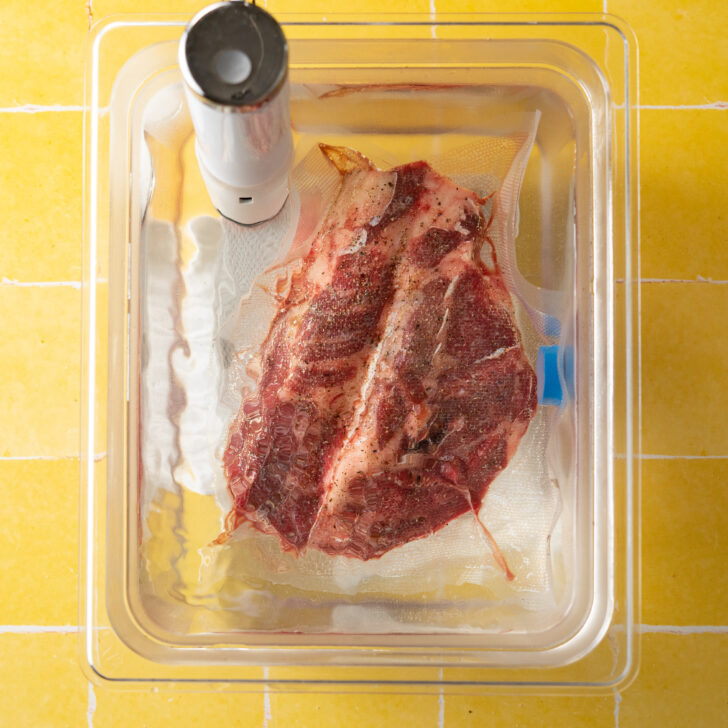
Cook the roast for 3-5 hours. Once it’s done, remove the roast from the bag and pat dry with paper towels. Preheat a cast iron skillet over high heat until smoking, then add a dollop of ghee. I like ghee because it has a higher smoke point than butter, but you can use butter, too.
Give it a good sear for 30-60 seconds on each side, then remove to a cutting board and let it rest for a few minutes before slicing and serving.
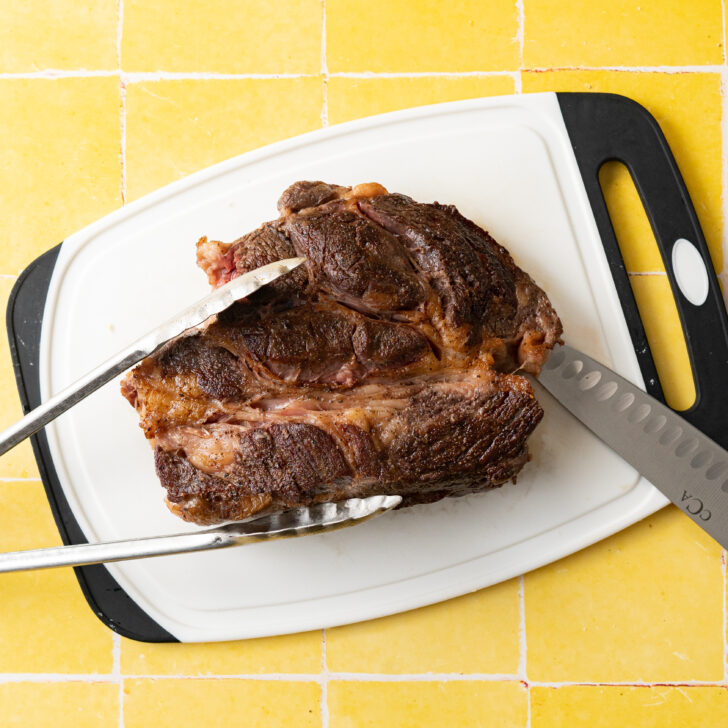
Make sure to whip up a batch of horseradish sauce and mashed potatoes to serve with this! If you want something a little fresher and zestier, you could do chimichurri and roasted potatoes instead. You really can’t go wrong here.
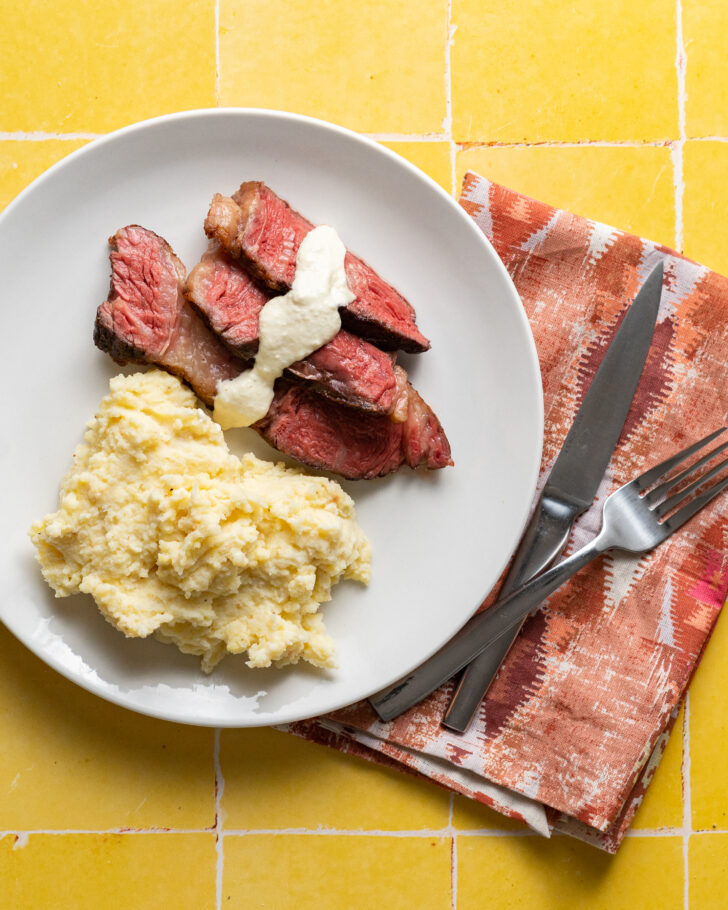
Common Questions
Yes! But I recommend freezing before sous viding. Season the roast, vacuum seal it, then pop it in the freezer. When you’re ready to cook, you can go straight from the freezer to the sous vide bath.
If you usually prefer meat rarer, I still recommend sticking with 135 F. This is a fatty cut and a higher temp renders all that fat better. If you like your meat more well done… that’s your prerogative! Try 140-145 F.
My favorite way to serve this is just like traditional prime rib: with horseradish sauce and mashed potatoes. If you want something a little fresher and zestier, you could do chimichurri and roasted potatoes instead. You really can’t go wrong here.
You can also view this recipe as a step-by-step web story here.
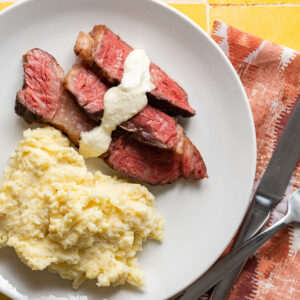
Get the Recipe:
3 Hour Sous Vide Chuck Roast (Prime Rib Dupe)
Ingredients
- 2-3 lb chuck roast
- 1 tbsp kosher salt
- 2 tsp black pepper, freshly cracked
- 2 tbsp ghee
Instructions
- Preheat water bath using immersion circulator to 135 degrees F.
- Season the chuck roast liberally with salt and pepper – you may find you need more than the amounts listed.
- Vacuum seal the chuck roast, or use another air removal method if you don't have a vacuum sealer.
- Add the vacuum sealed chuck roast to the preheated water bath. Use sous vide magnets or a ceramic plate or bowl to keep the bag submerged. Cook for 3-5 hours.
- When the roast is done, remove the roast from the sous vide bag and pat thoroughly dry with paper towels or a clean dish towel.
- Preheat a cast iron skillet over high heat. When smoking, add the ghee, let melt, and then add the chuck roast. Sear on each side for 30-60 seconds until browned.
- Let rest for a few minutes, then slice and serve. Serve with horseradish sauce and mashed potatoes.
Notes
- Ghee can be substituted for butter.
- To freeze this, freeze the roast after seasoning and vacuum sealing (before sous viding). This can be cooked from frozen.

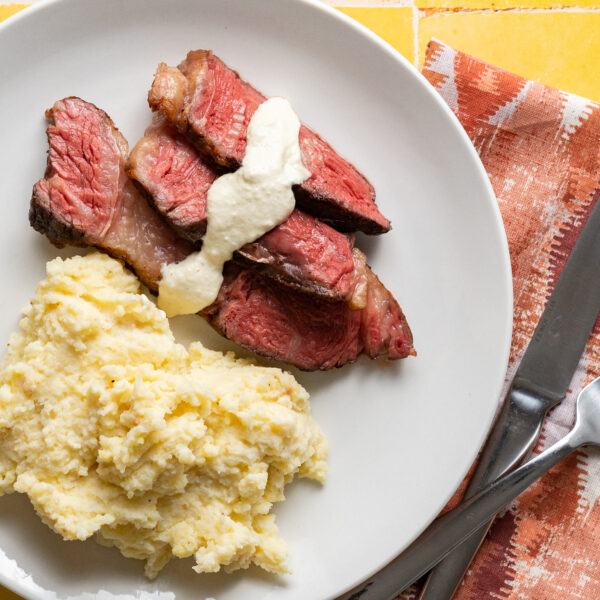
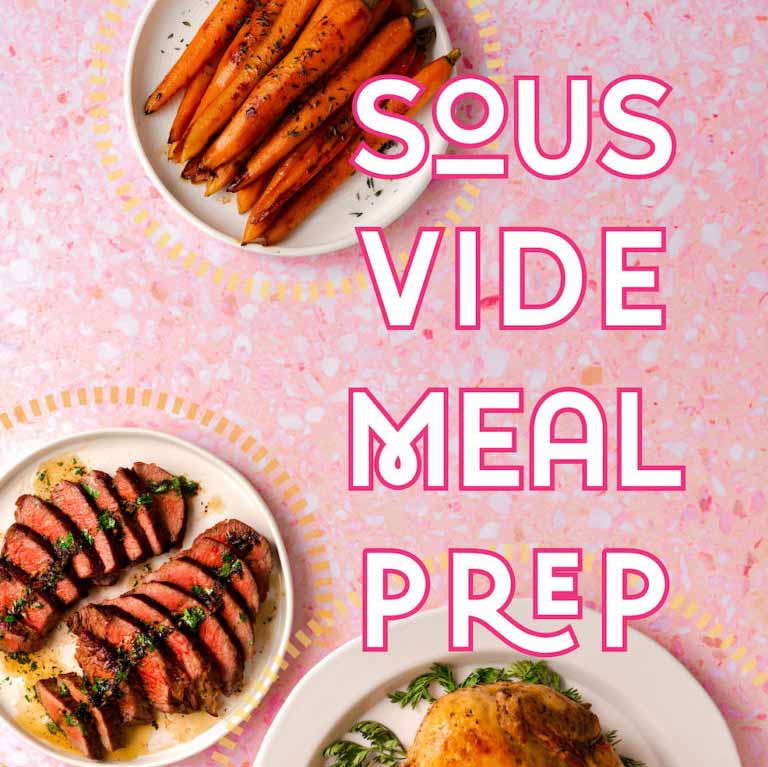
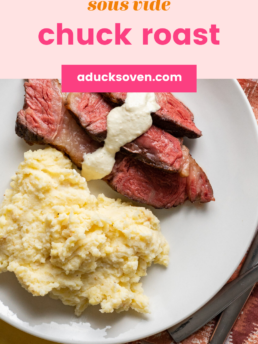
Why do other people say 24 hours or more for Chuck roast?
It all depends on the texture you’re after! If I wanted a shreddy, fall apart, pot roast like texture, I would do a longer cook at a higher heat. But for something steaky like this, a long cook isn’t necessary.
After a year of using Sous vide frequently, I’m still trying to figure out roast beef. As the other commenter said, most recipes call for much longer times, even 24 hours, and they use this even for good cuts like sirloin that don’t need tenderizing. When I leave things in Sous vide too long, the texture of the meat deteriorates. It’s hard to believe that chuck would be tender enough after only 3 hours. We like ours on tge rare side of medium rare and I usually cook at 130 or 131.
When cooking wild game or a very lean cut, what do you recommend.
I recently did a 5hr chuck roast sous vide, and it came out beautifully. Tears in my eyes as I had a bite of this tender, delectable steak. Thanks for sharing this recipe!
I’m so glad!!!
I cooked it for 5 hours sous vide in the APO(Anova Precision Oven) and it came out great but a little chewy. So I put it back to cook for a few more hours to see if I can get it to be more tender.
Great recipe though, got a terrific look(like in your photos) and a ton of flavor.
When you Google a chuck roast sous vide recipe what you find is a lot of 24 and 36 hour cooks. It’s hard to believe that 3 hours will be enough time to make it tender like a ribeye. You might want to edit the original post to include something that addresses this. Also would 6 hours be okay? Would it be more tender with 6 hours? Maybe have the hours it would take for ribeye like and maybe the hours for pot roast like beef. Thanks
I tried your 3 to 5 hr sous vide chuck roast recipe. Hate to say it but it turned out badly. Still very tough and not at all like prime rib. It wont go to waste however. I will use it in a soup or stew. I was not sure your idea was going to work and it really did not. I have used some of your other recipes and they have all been great.